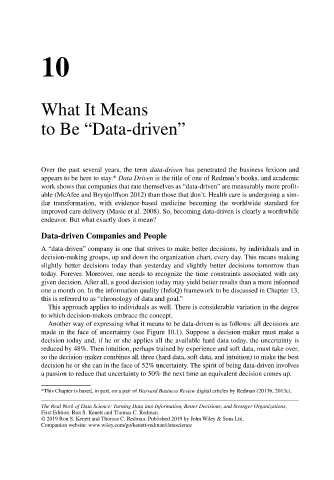Page 56 - The Real Work Of Data Science Turning Data Into Information, Better Decisions, And Stronger Organizations by Ron S. Kenett, Thomas C. Redman (z-lib.org)_Neat
P. 56
10
What It Means
to Be “Data‐driven”
Over the past several years, the term data‐driven has penetrated the business lexicon and
appears to be here to stay.* Data Driven is the title of one of Redman’s books, and academic
work shows that companies that rate themselves as “data‐driven” are measurably more profit-
able (McAfee and Brynjolffson 2012) than those that don’t. Health care is undergoing a sim-
ilar transformation, with evidence‐based medicine becoming the worldwide standard for
improved care delivery (Masic et al. 2008). So, becoming data‐driven is clearly a worthwhile
endeavor. But what exactly does it mean?
Data‐driven Companies and People
A “data‐driven” company is one that strives to make better decisions, by individuals and in
decision‐making groups, up and down the organization chart, every day. This means making
slightly better decisions today than yesterday and slightly better decisions tomorrow than
today. Forever. Moreover, one needs to recognize the time constraints associated with any
given decision. After all, a good decision today may yield better results than a more informed
one a month on. In the information quality (InfoQ) framework to be discussed in Chapter 13,
this is referred to as “chronology of data and goal.”
This approach applies to individuals as well. There is considerable variation in the degree
to which decision‐makers embrace the concept.
Another way of expressing what it means to be data‐driven is as follows: all decisions are
made in the face of uncertainty (see Figure 10.1). Suppose a decision‐maker must make a
decision today and, if he or she applies all the available hard data today, the uncertainty is
reduced by 48%. Then intuition, perhaps trained by experience and soft data, must take over,
so the decision‐maker combines all three (hard data, soft data, and intuition) to make the best
decision he or she can in the face of 52% uncertainty. The spirit of being data‐driven involves
a passion to reduce that uncertainty to 50% the next time an equivalent decision comes up.
1
*This Chapter is based, in part, on a pair of Harvard Business Review digital articles by Redman (2013b, 2013c).
The Real Work of Data Science: Turning Data into Information, Better Decisions, and Stronger Organizations,
First Edition. Ron S. Kenett and Thomas C. Redman.
© 2019 Ron S. Kenett and Thomas C. Redman. Published 2019 by John Wiley & Sons Ltd.
Companion website: www.wiley.com/go/kenett-redman/datascience

